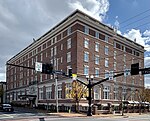Fort Loudoun (Virginia)

Fort Loudoun was a historic fortification of the French and Indian War, located in what is now Winchester, Virginia. The fort was built between 1756 and 1758 under the supervision of George Washington, then a colonel in the Virginia Regiment. It was named for John Campbell, 4th Earl of Loudoun, who commanded the British forces in North America for a time during the war. Washington and his militia regiment were headquartered at the fort for two years. The fort was a roughly square bastioned earthworks, whose extent spread across where North Loudoun Street runs.The property at 419 North Loudoun encompasses the historic heart of the fort, including a well dating to the fort's construction, and a portion of its northwest bastion. This area has been listed on the National Register of Historic Places. This property is now owned by the non-profit French and Indian War Foundation.
Excerpt from the Wikipedia article Fort Loudoun (Virginia) (License: CC BY-SA 3.0, Authors, Images).Fort Loudoun (Virginia)
North Loudoun Street, Winchester
Geographical coordinates (GPS) Address Nearby Places Show on map
Geographical coordinates (GPS)
| Latitude | Longitude |
|---|---|
| N 39.189166666667 ° | E -78.163888888889 ° |
Address
North Loudoun Street
North Loudoun Street
22601 Winchester
Virginia, United States
Open on Google Maps











